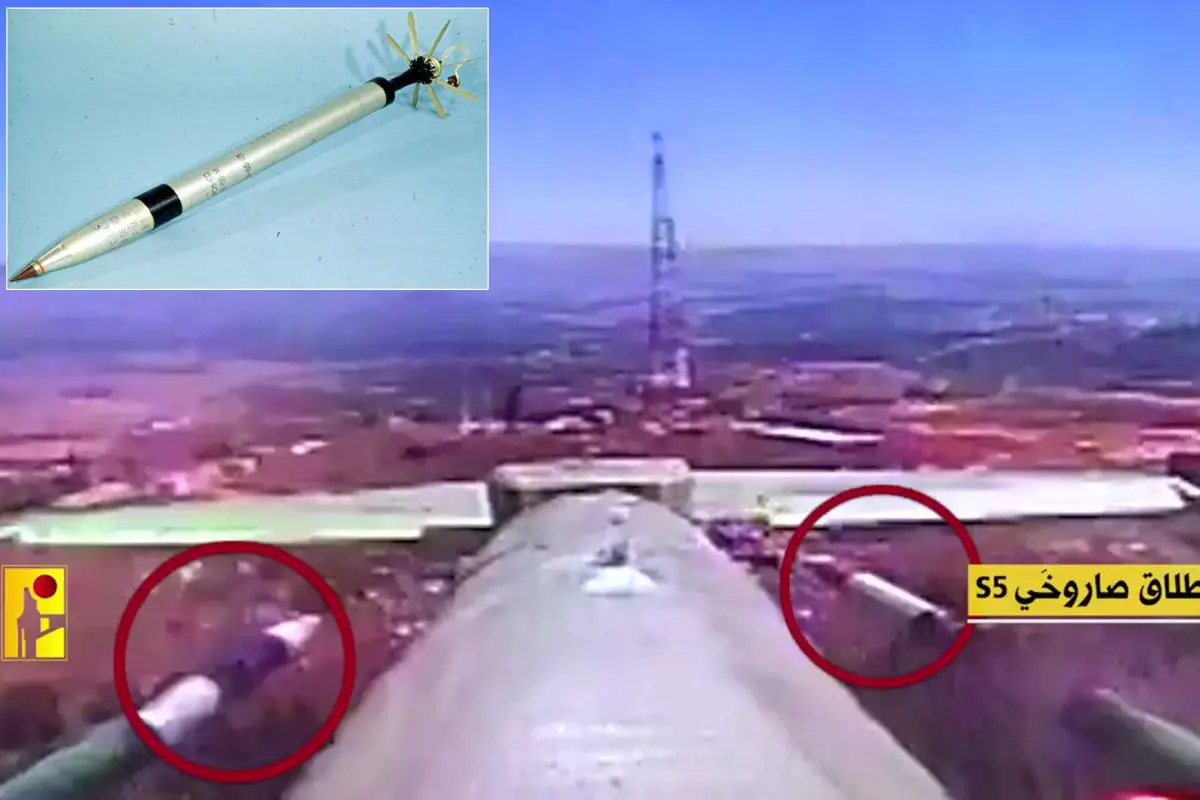Breaking news
Hezbollah deploys kamikaze drone armed with Soviet missiles in first-ever airstrike on Israel.
On May 16, 2024, the Lebanese militant group Hezbollah carried out its first airstrike, targeting the Israeli settlement of Metula with a newly developed kamikaze drone equipped with two S5 air-to-surface missiles. This marked a symbolic escalation in the conflict between Hezbollah and Israel. According to various sources, the drone successfully hit an Israeli military vehicle, resulting in the deaths of two Israeli soldiers and injuries to others.
Follow Army Recognition on Google News at this link

The drone, armed with two S5 missiles, flew over Metula and first struck an Israeli military vehicle before targeting an IDF garrison. After deploying its missiles, the kamikaze drone continued on its path and exploded upon impact with another target. (Picture source: Twitter/Middle East Observer)
Metula, situated near the Lebanese border, holds strategic military significance due to its location and the presence of both civilian and military infrastructure. The settlement's proximity to the border makes it a key area for monitoring and potential defense operations against ground incursions, making it a significant target for Hezbollah's operations aimed at disrupting Israeli defense and surveillance capabilities.
Hezbollah's military media released video footage of the operation, showing the drone launching its missiles. The drone, armed with two S5 missiles, flew over Metula and first struck an Israeli military vehicle before targeting an IDF garrison. After deploying its missiles, the kamikaze drone continued on its path and exploded upon impact with another target. This method allows Hezbollah to bypass Israel's aerial defenses and carry out airstrikes without the need for conventional airstrips, which are vulnerable to Israeli airstrikes.
The S5 missile used in the attack is a Soviet-era 57 mm unguided air-to-surface rocket. It is 1.4 meters in length, weighs 5 kilograms, and has a range of approximately 4 kilometers. The missile is equipped with a high-explosive warhead and a solid-propellant motor, originally designed for use by fighter-bombers and helicopters. The S5 features folding tail fins for improved stability during flight. Hezbollah has adapted these missiles for use with their drones, indicating a tactical evolution in their ability to conduct aerial strikes without relying on traditional, more detectable launch platforms.
In retaliation for the drone attack, the Israeli Air Force conducted strikes on Hezbollah positions in Lebanon, specifically targeting a weapons manufacturing plant in Baalbek. This plant was believed to be involved in producing guided munitions and drones. The Israeli strikes are part of a broader effort to counter Hezbollah's increasing military capabilities.
Historically, Hezbollah has transitioned from a guerrilla group to a well-equipped militia with a significant arsenal, including rockets, missiles, and now various armed drones. Their arsenal is estimated to include around 150,000 to 200,000 rockets and missiles, with substantial support from Iran. The deployment of kamikaze drones armed with S5 missiles demonstrates Hezbollah's strategy to increase pressure on Israeli military positions. Since October 2023, Hezbollah has conducted numerous attacks on Israeli communities and military posts along the border, resulting in significant casualties on both sides.
Since its declaration of independence in 1948, Israel has experienced various military attacks, including airstrikes. One of the earliest incidents occurred immediately after its independence declaration on May 14, 1948, when Egyptian aircraft bombed Tel Aviv. This marked the beginning of the 1948 Arab-Israeli War, involving multiple air attacks by the Arab states of Egypt, Jordan, Syria, Iraq, and Lebanon as part of their broader military campaigns against Israel.
In later decades, Israel faced additional airstrikes during significant conflicts. During the Six-Day War in 1967, the air forces of Egypt, Jordan, and Syria attacked Israel. Similarly, during the Yom Kippur War in 1973, Israel was subjected to substantial air assaults by Egypt and Syria. The Second Lebanon War in 2006 featured extensive rocket and missile attacks from Hezbollah into northern Israel, which were part of a broader strategy that also included airstrikes and ground operations by Israeli forces in response to Hezbollah's actions.
More recently, Israel has been targeted by rocket fire and drone attacks from non-state actors such as Hamas and Hezbollah. Since 2005, Gaza-based groups have frequently launched rockets into Israeli territory, prompting military operations like Operation Cast Lead (2008-2009), Operation Pillar of Defense (2012), and Operation Protective Edge (2014). These operations were responses to ongoing rocket fire targeting Israeli civilian areas. Additionally, the conflict has seen an increase in locally-made drone and missile attacks by Hezbollah, including the use of the Tharallah twin anti-tank guided missile system, specifically designed to counter the Trophy Active Protection System (APS) mounted on Israeli Merkava tanks.


























